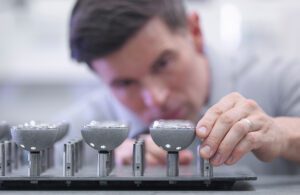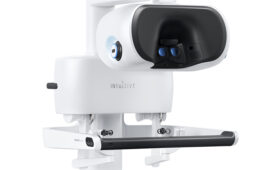
An engineer inspects artificial hip joint parts. [Photo courtesy of Xebec]
The latest automated cutting tools help medical device manufacturers meet strict specs and high demand.
Dave Sawicki, Xebec
Increasing demand and advances in technology are driving growth in the medical device industry. Chronic diseases are more prevalent, and the aging population is larger, contributing to the demand for highly regulated Class III medical devices such as pacemakers, artificial hips and heart valves. And focused research and development mean today’s medical devices must perform better, longer.
This market reality puts more pressure on medical device manufacturers. To pass inspection and guarantee longevity and performance, they must achieve high-quality surface finishes and tighter dimensional tolerances. To meet demand, they must do so as quickly and efficiently as possible while still complying with strict industry standards and regulations.
Deburring and surface finishing are consequential phases in producing medical parts and devices requiring precision and quality. One missed detail can discount all prior work on the piece, turning it to scrap or sending it back through production. And one overlooked detail that still passes inspection could have detrimental consequences downstream.
With the industry’s tightening standards, high demand and greater device complexity, automating these processes with high-quality tools like ceramic fiber brushes that have a long tool life and the most consistent performance can alleviate strain on production capacity and even allow manufacturers to take on more work despite the labor shortage. And these unique cutting tools with flexible bristles can remove burrs without altering part dimensions to maintain dimensional integrity.
Why medical devices must be beautiful
Most medical tools and devices must be burr-free after production. Many must also have mirror-fine surface finishes. Those that don’t require a mirror finish have strict finishing and polishing requirements to prevent irritation and infection.
These requirements are not about producing an attractive part. They’re about producing a functional part that will last its expected life and perform smoothly. For implants, these requirements also affirm biocompatibility, ensuring parts are suitable for implantation and won’t be rejected or vulnerable to stress or corrosion. For load-bearing devices, they affirm the parts will sustain performance and withstand pressure.
Requirements are particularly strict with FDA Class III and Health Canada Class IV devices on which human life will depend or pose a high risk for the patient. With demand exploding for medical devices like joint replacements and pacemakers as populations age, the selection of materials used by medical implant and device manufacturers continues to change. Manufacturers are seeking more innovative ways to improve the quality and longevity of implants and devices, and they need a high-tech tool to deburr and finish these materials to precise specifications, like those with ceramic fibers that are self-sharpening, exposing new cutting edges as they wear.
If a manufacturer doesn’t have long-lasting tools to meet these specifications on time, production and throughput will suffer. For instance, many manufacturers still have employees deburring and finishing these critical parts by hand. This is time-consuming and difficult to produce quality parts consistently. And the reality is finding skilled labor for such work is becoming more challenging.
Take a knee (for example)
One great example of a medical device that must be precisely produced is a knee replacement. There are two main components that operate together to perform the function of the knee: the concave cup and the convex ball. These parts are meant to swivel and pivot as a natural knee would.
To achieve these motions, the parts must be manufactured to tight tolerances, cutter marks removed and precisely polished. The complex shapes of these parts mean it’s challenging to deburr and finish them by hand or with inadequate automated tools. Employees who hand deburr must remove the tiniest marks and create perfect surface finishes, which inevitably yields inconsistent results (because they’re only human and get tired as the day goes on) and leads to frequent and costly scrap.
If a knee replacement isn’t to spec or quality but passes inspection and is implanted in a patient, it might result in misalignment, instability, corrosion, premature wear and other issues. This could affect patient quality of life and generate a higher cost of care. It can even lead to device failure.
Deburring and finishing with an automated cutting-edge solution that works like a cutting tool turns out high-quality, consistent results. Such a tool can shrink the hours-long processes of deburring and finishing down to minutes or even seconds.
Achieve beautiful outcomes in less time
Medical device manufacturers can achieve better, higher-quality results and even increase production when they automate deburring and finishing with tools like ceramic fiber brushes that can be incorporated into the CNC program. These brushes perform like long-lasting cutting tools, completing the deburring and finishing process in one step with impressive outcomes.
Choosing the right deburring tools to automate production helps manufacturers remove all burrs and achieve impressive finishes as required by the customer. Manufacturers can more readily meet strict criteria while saving time and labor by reducing manual work. They can even save post-machining polishing time as the tool improves finish while the part is on the machine.
These benefits are key to maintaining the reputations of premier medical device manufacturers by consistently producing superior quality parts and reducing the likelihood of downstream issues.

Dave Sawicki is the senior application specialist and sales director of IPT America – Xebec Deburring Technologies. [Photo courtesy of Xebec]
The opinions expressed in this blog post are the author’s only and do not necessarily reflect those of MedicalDesignandOutsourcing.com or its employees.


![A photo of the Medtronic GI Genius ColonPro polyp detection system flagging a potential sign of colon cancer during a colonoscopy. [Photo courtesy of Medtronic]](https://www.medicaldesignandoutsourcing.com/wp-content/uploads/2024/04/Medtronic-GI-Genius-doctors-268x170.jpg)

